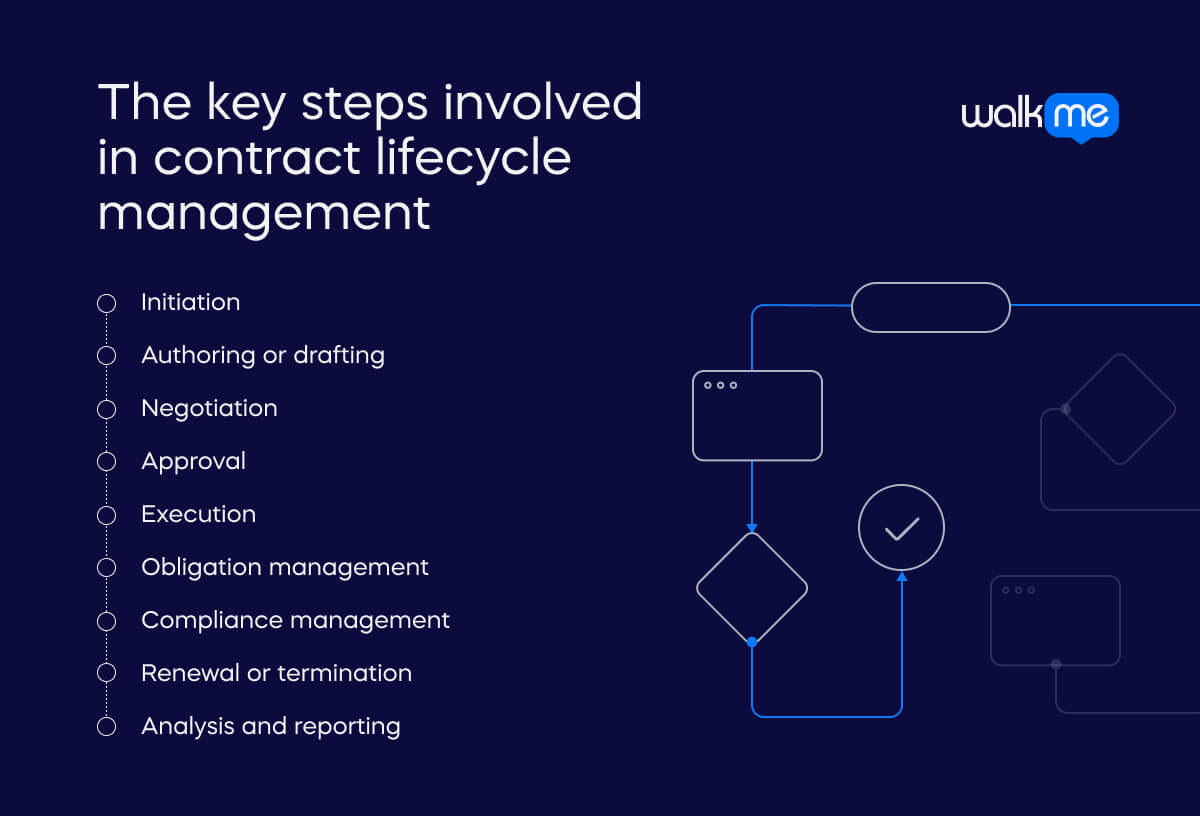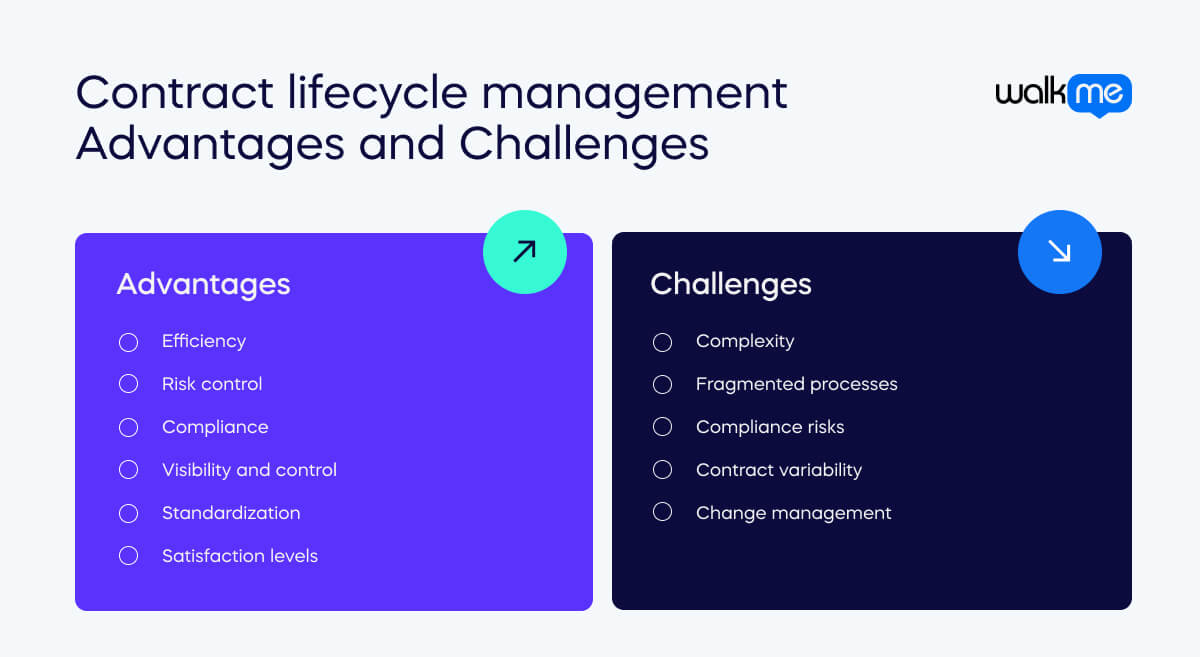Contract lifecycle management is the process of handling contracts. It is important to follow a series of steps from start to finish.
This setup helps people to handle contracts smoothly, reducing mistakes and making sure everyone follows the rules.
CLM cannot be ignored in today’s workplace. Statistics show that the global lifecycle management market is expected to reach $3.69 billion by 2032.
Furthermore, contract management impacts a good portion of the workforce – 32%, according to findings from World Commerce & Contracting.
With that in mind, it’s imperative for businesses to understand contract lifecycle management and utilize the digital tools available to them.
What are the key steps involved in contract lifecycle management?

Navigating a contract’s journey involves a series of important steps, ensuring it works well from start to finish.
This includes stages like deciding what the contract will include and getting everyone to agree on it. Once it’s agreed upon, everyone signs it to make it official. Then, people have to do what the contract says they’ll do.
Lastly, people look at how well the contract worked and see if there are any ways to make it better next time.
Here’s a closer look at what is usually involved:
Initiation
- Deciding if a contract is needed
- Working out what the contract will include
- Figuring out who will be involved
Authoring or drafting
- Laying out the terms and conditions
- Describing the responsibilities those involved have
- Including deadlines and other important details
Negotiation
- Those involved may discuss the terms and conditions
- There may be back and forth until everyone agrees
- They will want the contract to benefit everyone
Approval
- The contract may need to be reviewed
- This applies if there are relevant stakeholders within the companies
- After review, the finalized terms will be approved
Execution
- Everyone signs the contract, making it official
- The document is now legally binding
Obligation management
- Those involved must carry out their duties
- CLM systems may be able to track and manage the obligations
Compliance management
- Both parties must follow the terms of the contract while it is active
- CLM software may have compliance monitoring features
- This will track whether people are following the terms and requirements
Renewal or termination
- There may be set end dates or termination clauses in the contract
- CLM software can manage the renewal process
- It can also terminate contracts by following the rules which were laid out
Analysis and reporting
- CLM systems often have reporting and analytics features
- They will give insight into how the contract performed
- People can also identify any compliance issues
- Opportunities for improvement can be found as well
Contract lifecycle management vs. contract management
Contract lifecycle management and contract management may sound like the same concept, but they are actually separate terms:
- Contract management focuses on the day-to-day tasks related to individual contracts
- Contract lifecycle management takes a broader view, aiming to improve efficiency, reduce risk, and maximize the value derived from all contracts across the organization
Here’s a more granular overview:
| Contract lifecycle management | Contract management | |
| Definition | Handling contracts from start to finish
Making sure everything goes as planned |
Looking after contracts after they’re signed
Making sure they’re followed correctly |
| Focus | Managing contracts throughout their whole life, from making them to finishing them | Taking care of contracts once they’re signed, making sure they’re done right |
| Techniques | Making contracts
Automating work Keeping documents Checking how well things are going Analyzing contracts |
Watching contracts
Checking if contract sections are rolled out on time Fixing problems Changing sections in contracts Looking at risks Managing relationships |
| Goals | Make sure contracts are followed
Get the most out of contracts Avoid problems Keep good relationships |
Make sure contract sections are actioned
Keep promises Solve problems Adjust to changes Keep good relationships |
Use cases for contract lifecycle management
Here is how contract lifecycle management can manifest in the workplace:
Procurement contracts
- A manufacturing company uses contracts with suppliers to buy materials.
- They manage these contracts from start to finish, making sure everything goes smoothly.
- This helps them save money and work better with suppliers.
Client agreements
- A consulting firm makes deals with clients to provide services.
- They handle these agreements from the beginning to the end, making sure everything is done right.
- This helps them avoid problems and keep clients happy.
Partnership agreements
- A software company partners with others to sell its products.
- They manage these agreements from start to finish, making sure partners do well.
- This helps them grow their business and sell more products.

Advantages of contract lifecycle management
Having a robust contract lifecycle management process helps in the following ways:
Efficiency
Contract lifecycle management makes handling contracts easier from start to finish, saving time and reducing mistakes.
Risk control
The process helps avoid problems by keeping track of important dates and making sure everyone sticks to the agreement.
Compliance
It ensures that contracts follow the rules and laws, reducing the chance of getting in trouble.
Visibility and control
It lets everyone see what’s happening with contracts in real-time and helps make better choices.
Standardization
Contract management makes sure that everyone uses the same rules and templates, avoiding confusion.
Satisfaction levels
By managing contracts well, it keeps customers and suppliers happy, building trust.
Challenges of contract lifecycle management
Using a DAP to help with CLM assists with mitigating challenges such as:
Complexity
Contract management is hard because it involves many steps and people.
Fragmented processes
Sometimes, contracts are managed using different systems and methods, which can cause mistakes.
Compliance risks
Making sure contracts follow the rules can be tricky without the right tools.
Contract variability
Contracts can be different from each other, making it hard to keep things consistent.
Change management
Making changes to how contracts are managed can be difficult if people don’t want to change.
How can DAPs help with contract lifecycle management?

A Digital Adoption Platform (DAP) like WalkMe.com can support and improve contract lifecycle management. Here’s how:
Guided contract creation
DAPs offer step-by-step help and tutorials for creating contracts in CLM software. This makes sure users understand how it works and fill out forms correctly.
| How can WalkMe help?
Guided workflows give users step-by-step instructions in CLM software. This means fewer mistakes and allows workers to get more done in less time. |
Automated workflows
These platforms can handle repetitive tasks in CLM software. Examples include sending messages to say a contract is approved or announcing that it’s time to renew. This makes the process smoother and lowers the chance of mistakes.
| How can WalkMe help?
WalkMe Automation can perform repetitive tasks for employees. The automated workflows can also fill out forms and be guided to complete similarly simple tasks, making the process smoother. |
Training and onboarding
The software has training lessons and step-by-step guides for CLM software. This helps people learn how to use the platform fast. It makes it easier to understand and use the software for handling contracts.
| How can WalkMe help?
WalkMe can be overlaid with CLM software, offering Smart Walk-Thrus to help new users learn how to use the platform well. This speeds up the learning process. |
Real-time assistance
DAPs can give people advice and support as they use the CLM software. They offer tips, suggestions, and help with any problems people might encounter while working with contracts.
| How can WalkMe help?
WalkMe provides ShoutOuts which can appear at scheduled times. They can also pop up in response to people carrying out specific tasks within CLM software. They are helpful for directing people to the support they need – at the moment they need it. |
Success stories with contract lifecycle management
WalkMe has been instrumental in helping companies of all shapes and sizes to improve their contract lifecycle management processes.
Here is how Nestle achieved success with the DAP.
Nestle x WalkMe
Nestle worked with Charlton House, a WalkMe Certified Partner, on building WalkMe content for their SAP Ariba interface.
As a result, they have seen much quicker turnaround times for contract signatures and a smoother experience for their suppliers.
Furthermore, the company has seen a 250% increase in user interactions for critical fields.
In other words, people are now filling out accurate data, which means Nestle has less support tickets to deal with.
Nestle’s NPS scores for SAP Ariba have jumped up by 63% since WalkMe was deployed across the platform.
Future of contract lifecycle management with DAPs
Contract lifecycle management (CLM) is becoming more sophisticated when software is integrated with digital adoption platforms.
These platforms are changing how organizations handle contracts. They make processes smoother, help teams work together, provide useful information, ensure rules are followed, and allow for easy growth.
With technology advancing, CLM will become even easier, helping organizations manage contracts more efficiently and effectively.